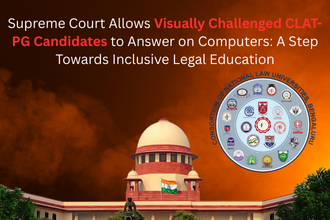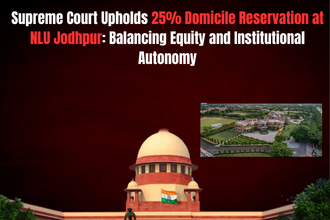The Supreme Court of India has once again emphasized the importance of accessibility and equal opportunity in education by directing that visually impaired candidates appearing for CLAT-PG (Common Law Admission Test – Postgraduate) must be allowed to use assistive technology to answer questions. The Court mandated facilities like JAWS (Job Access With Speech) screen reader software, customized keyboards, and mouse, along with the option to answer on a Word document directly on the computer. Importantly, candidates will still retain the choice of using a scribe in accordance with government guidelines.
This landmark order came in the case titled Yash Dodani & Ors. v. Union of India & Ors. [Writ Petition (Civil) No. 785/2024], and was delivered by a bench comprising Justice Surya Kant and Justice Joymalya Bagchi on August 21, 2025. The ruling builds upon earlier interim directions issued in December 2024 for visually impaired candidates appearing in the All India Bar Examination (AIBE), thereby extending those benefits to future editions of CLAT as well.
Background of the Case
The petition was filed by visually impaired law students who sought equal opportunity to appear in CLAT-PG 2024-25 and the AIBE. They highlighted that despite their competence, the lack of adequate facilities such as screen readers and computer-based answering systems placed them at a severe disadvantage.
Previously, on December 5, 2024, the Supreme Court had directed the Bar Council of India (BCI) to provide facilities for visually impaired candidates for the AIBE. This included:
- Availability of JAWS and NVDA screen readers,
- Permission to use personal customized keyboards and mouse,
- Allowing installation of software a day prior to the examination,
- Granting candidates the option to answer questions on a computer or through a scribe.
On December 11, 2024, the Court further clarified that any scribe assisting a candidate must not belong to the fields of humanities or law, and should have an educational qualification one step below the candidate, aligning with the Government of India’s 2018 guidelines.
By extending these interim directions to CLAT-PG, the Supreme Court has ensured that visually impaired candidates are not deprived of fair opportunities in one of the most prestigious law entrance examinations in the country.
Supreme Court’s Observations and Directions
The Court categorically held that the interim directions of December 2024 will apply mutatis mutandis (with necessary changes) to future editions of CLAT.
Quoting the order:
“Meanwhile, the interim directions issued by this Court on 05.12.2024 and 11.12.2024 shall apply mutatis mutandis in the CLAT Examination in future to be conducted by the respondents.”
Additionally, Additional Solicitor General (ASG) Archana Pathak Dave informed the Court that fresh guidelines were issued on August 1, 2025, in light of the earlier orders. The Court directed that both the Bar Council of India and the CLAT Consortium must adhere to these updated guidelines.
The matter has now been posted for further hearing on November 13, 2025.
Importance of the Judgment
This ruling carries significant implications for both disability rights and legal education in India.
1. Promotes Accessibility in Education
The order recognizes the importance of assistive technology in bridging the accessibility gap for visually impaired students. By allowing the use of screen readers and customized hardware, the Court ensures that these candidates can compete on equal footing with others.
2. Ensures Compliance with Disability Rights Framework
India is a signatory to the United Nations Convention on the Rights of Persons with Disabilities (UNCRPD). The Supreme Court’s decision aligns with the spirit of the Rights of Persons with Disabilities Act, 2016, which mandates equal opportunities in education and employment.
3. Sets a Precedent for Other Examinations
The extension of these directions from the AIBE to CLAT signifies that similar accommodations may be sought for other competitive examinations as well, including judicial service exams, UPSC, and state PSCs.
4. Balances Fairness in Examination System
The Court’s insistence on government guidelines regarding scribes ensures that while visually impaired candidates are assisted, the sanctity and fairness of the examination process are maintained.
What This Means for Visually Impaired CLAT Aspirants
With this ruling, visually challenged candidates preparing for CLAT-PG 2026 and beyond can expect the following facilities:
- Use of JAWS or NVDA screen reader software during the examination.
- Permission to use personal customized keyboards and mouse.
- Option to answer directly on Word document on the computer.
- Facility to install assistive software a day prior to the exam.
- Freedom to choose between answering on the computer or using a scribe.
- Assurance that scribe qualifications will follow government-prescribed norms (not from law/humanities background and one educational level lower).
This levels the playing field and enables visually impaired candidates to attempt CLAT-PG without being dependent solely on scribes.
Wider Implications for Legal Education
The Supreme Court’s intervention highlights that accessibility in education is not charity but a right. By making CLAT inclusive, the Court has taken a step toward ensuring that law schools across India become more diverse and reflective of the society they serve.
Furthermore, it emphasizes the need for the CLAT Consortium and law universities to actively incorporate disability-friendly infrastructure and policies. This includes accessible classrooms, libraries, moot courts, and digital resources.
Conclusion
The judgment in Yash Dodani & Ors. v. Union of India & Ors. represents a progressive move by the Supreme Court to safeguard the rights of visually impaired law aspirants. By extending the earlier AIBE accommodations to CLAT, the Court has reinforced the principle of inclusive education.
This ruling not only empowers visually challenged candidates but also paves the way for greater awareness about disability rights in India’s education system. As the matter is set to be heard again on November 13, 2025, it is expected that further clarity will emerge on the implementation of these guidelines.
The Supreme Court’s decision is a victory for accessibility, equality, and justice—values that form the very foundation of the legal profession.
Also Read
Supreme Court Warns NGO Over Forged Letter in Smartworks IPO Case: Key Highlights and Legal Analysis
Supreme Court Raps AIADMK MP CV Shanmugam in “Ungaludan Stalin” Scheme Case; Imposes ₹10 Lakh Costs



